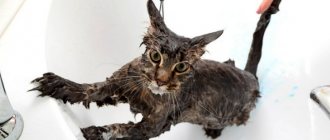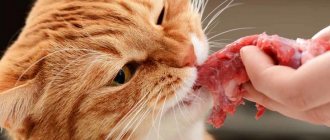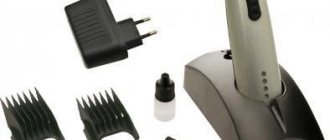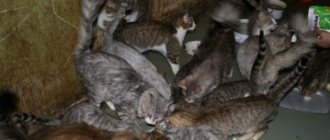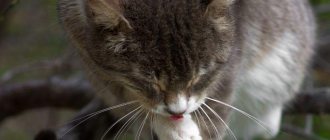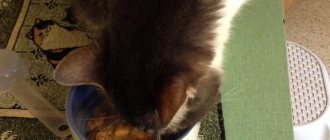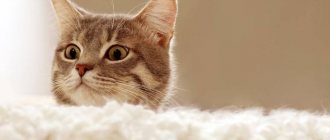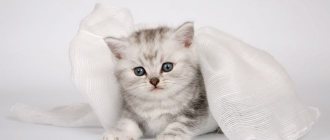Grooming cats is a newfangled invention that has received a large number of fans and opponents. Veterinarians are against such excesses and are confident that you can cut your pet’s hair only when necessary, and not for your own pleasure. Animals do not react well to imposed changes; they may become depressed, hide from their owner for a long time, or begin to take revenge.
Why do pets get haircuts? Why is hair cutting and shaving of cats not recommended by experts? What consequences can result from ignoring the opinion of veterinarians?
Caring for Persians
The Persian breed is much more difficult to care for than other cats. They are problematic to wash, comb, comb out debris, and the like. If you do not regularly care for your furry pet, the fur will become covered with tangles, which are removed only during the cutting process. The condition of the Persian's coat clearly indicates the health of the cat. Daily care for the hair of Persian cats takes a lot of time and effort. Therefore, you can solve this problem by going to a hairdressing salon for animals, where they will give your pet a haircut. Although adult cats react aggressively to being groomed in a new place and by an unknown person. It’s worth accustoming your pet to visiting a stylist and hygiene procedures while still a kitten:
Why is it not recommended to groom cats?
Veterinarians and professional breeders have a negative attitude towards trimming the coat at the whim of the owner. The main danger of haircuts is the high probability of changes in the structure of the hairs. The newly grown coat may become thinner and its quality may deteriorate, leading to the rapid formation of tangles. The changes also affect the cat’s skin – its elasticity and firmness may decrease.
Cooling has a negative effect on proper hair growth - in bare areas the skin temperature decreases. Some pets develop patches of baldness - the cut hair does not grow back. The problem of alopecia is more common in canines, but some felines also experience it.
Purebred pets may lose the right to attend exhibitions: after clipping, the hair begins to curl, becomes excessively fluffy or short. Such conformation defects are the main reason for the disqualification of cats.
Not all pets calmly allow their appearance to change. To obtain a fashionable hairstyle, the animal is put under anesthesia, which can seriously harm its health. In rare cases, the procedure ends in death for the cat - under the influence of the drug, cardiac activity and breathing stop.
Types of haircuts for Persian cats
During hot summer weather, your pet will benefit from a summer haircut. This is the kind of haircut that will allow your furry to feel comfortable and not sit near the air conditioner all day long.
Often, haircuts are performed during the animal's molting period. Indeed, at such a moment, the Persian’s long and thick fur can be seen anywhere in the apartment, which causes inconvenience. The pet develops tangles. If you do not turn to specialists in grooming Persian cats, but cut and comb them yourself, then the cat will develop bald spots and you can mechanically damage the skin.
Grooming benefits your animal. But you must agree that a fashionable and unusual haircut will add a certain amount of charm to your pet.
The technique of grooming Persian cats is complex due to the nature of their coat. Soft wool is difficult to cut with a clipper, so you should run the nozzle over the same area of skin several times. There are a considerable number of types of haircuts for Persian cats:
- the standard type of haircut for a Persian cat or otherwise “like a lion cub.” This is cutting off the fur everywhere, excluding the head, the lower parts of the paws and the tip of the tail, where the tassel remains;
- classic haircut called “puma”. It is somewhat similar to a “lion cub” haircut. But in this version, the hair on the cat’s front paws and on the front part of the body is not cut. Just trim it with scissors. All other wool is clipped. Do not touch the toes on the hind legs and the tip of the tail;
- cutting a herringbone or mohawk. The entire body is clipped, and the hair is left on the head, ridge and tail. The fur on the back is cut into herringbone stripes;
Getting used to combing
You need to accustom your Persian cat to the brushing procedure as early as possible, gradually, gently, but persistently. It is very useful to combine training with play so that the kitten perceives this procedure as part of an enjoyable activity. Place the cat on your lap on its back. Carefully and gently comb the fur first on the neck, then between the front legs, in the armpits, on the belly and on the hind legs. You need to comb the fur first against, and then in the direction of its growth. Then, with the cat on its paws, comb the fur on its back and tail.
If you don't start brushing her early, she may develop an aversion to brushing, which will eventually make it difficult to keep her coat in good condition. One way to train your cat to accept being brushed is to brush her right before serving food. This way, your cat will associate brushing with getting food (something she likes).
This procedure requires frequent daily repetition only during the kitten’s training period. Try not to overload your pet with “science,” but also do not indulge his desire to stop the procedure on his own. If you haven't finished brushing, let your cat know that she can only leave if you want her to. You will need to comb your dog no more than once every 2-3 days, and this procedure will take no more than 5 minutes.
Tail haircuts for Persian cats
Options for cutting the tail of Persians are:
The first two types differ from each other in the way the wool is cut. The brush is made rounded. And the hair for the broom is cut in a straight line. For a squirrel tail, the hair at the base of the tail is cut with a clipper. The remaining wool is then trimmed and shaped using thinning scissors.
Paws are also cut in a model manner:
- in the form of “socks”. The toes are cut just above the wrists of the paws;
- in the form of "golfs". Socks are cut just below the body.
Remember a number of rules:
- do not cut the tail brush so that the fluffy does not bite or chase it;
- do not cut the fur completely, leave at least 3mm;
- The cat's ears and face remain uncut.
Grooming a Persian cat means helping yourself and your furry friend with hygiene and grooming issues. And also observing your pet from a new and unknown side.
How to trim or shave your pet if necessary?
Hairdressing procedures at home are carried out according to a certain algorithm:
- Trimming nails. It is carried out with special tweezers, pre-disinfected. Light pressure on the paw pads causes the hidden claws to extend; the owner only needs to trim the very tips. This procedure will prevent scratches during cutting.
- When performing the initial manipulation, an assistant is needed - he must hold the animal, preventing it from running away. Some cats become aggressive when they see grooming tools. For safety, the pet is wearing a plastic collar that prevents it from biting.
- The cat is laid on its side, its paws are securely fixed. For cutting, use a clipper or scissors. The first will avoid damage to the skin, but can irritate and frighten the pet with its buzzing.
- The fur is removed from the sides, then moved to the back and belly. Hair removal is carried out both in the direction of its growth and in the opposite direction. The remaining long hairs are trimmed with nail scissors. There must be a tassel on the tail.
After the procedure is completed, the pet is bathed with a special cat shampoo and dried with a towel. If the animal is not afraid of a hair dryer, then it is also used for drying. Veterinarians recommend using the services of specialists. The groomer will carry out the manipulation quickly, without injuring the cat’s delicate skin or damaging the whiskers.
How often can you shave or cut your pet's hair? The fur grows back within 3-6 months. If spots form, the animal grows unevenly, then it needs to be shown to a veterinarian.
Is it possible to trim a Persian cat?
Is it possible to trim a Persian cat?
When summer and hot, sultry days come, many cat and dog owners are faced with the question of whether we should cut our animal’s hair in order to somehow make life easier for him during the heat of the summer months. Imagine that our pet constantly wears a natural fur coat, how lucky he is! But there are times when cats and dogs simply need to be cut, no matter what. Won't we harm our pet by doing this?
Is it possible to trim a Persian cat?
Let me digress a little: I found a website about cat breeds - just a unique project, it describes breeds that we have never seen before, and there are also photos! I advise you to visit this site Cat Breeds with photographs and show these wonderful materials to your children!
Owners of Persian cats who exhibit their pets at cat shows are very meticulous about the appearance of their pets, they take care of them in such a way that they do not need any haircut, and it will even harm them when receiving grades and points.
And if we don’t go to cat parties at all, our cat is very lazy, his fur falls off, what should we do? Maybe I should still get a haircut? You definitely need to trim it by the summer, if your cat goes outside so that he doesn’t freeze, look at the weather now and the forecast for the next week, if the weather is already warm, then you can get a haircut. A cat who is never outside can go bald all year round!
Actually, there is nothing fatal here. One has only to think carefully about why a cat should be trimmed? All cats and dogs have seasonal shedding, we know this well. At the beginning of summer, cats shed a lot of hair and down, which are very important for warming the animal in winter. Regular, almost daily brushing can alleviate the cat’s condition and rid your home of a huge amount of hair on carpets, rugs, and upholstered furniture.
It is better, of course, not to cut cats at all; Mother Nature did not provide for such a stressful method of caring for animals. But there are times when it is simply necessary to cut a cat's hair. For example, if the animal is no longer young and no amount of combing, bathing or vitamins helps. The fur falls into tangles, greatly disturbing the cat. And many cats cannot tolerate the combing procedure at all, they yell, scratch and run away from their caring owners to a secluded corner.
Here comes the moment of forced haircut! It’s better to torture your pet, but then it will be easy and comfortable for him when he comes to his senses a little after the haircut. Various bacteria accumulate in the tangles; it is very difficult to wash the cat, and it is almost impossible to comb it out. The tangles are usually located in close proximity to the skin, almost close. You can try to carefully cut out the tangle with scissors, but there is a danger of injuring the skin.
It is very convenient to cut a Persian cat with an electric clipper, but a special one for soft fur. When changing attachments, you can leave the fur length at 3, 6, 9 mm - whatever the owner likes best. It is advisable to completely remove the fur from the tummy and inside the hind legs, that is, trim the cat's hair. There is no need to cut the tip of the tail, the pads of the paws and the head; let your exhausted pet spend a little time as the king of animals - the lion.
In what cases can you not do without a haircut?
Most owners have their own opinion about the indications for grooming a cat:
- getting rid of fur on furniture and carpets during seasonal shedding;
- allergies in the owner and family members (a shorn animal has less fluff, which causes an allergic reaction);
- prevention of overheating (in the summer, cats are hot due to their thick fur coat);
- solving problems with hair (it is easier to remove fleas, ticks, burrs).
Owning a representative of a long-haired breed while suffering from allergies, helping a pet in the heat, solving the problem of seasonal shedding - experts treat such wishes with irony. These are the whims of the owners, and not a real need. Professionals allow haircuts only in two cases:
- To get rid of large tangles. Matted fur causes pain and itching, and involuntary scratching of problem areas. When there is a massive accumulation of them, the cat is cut to relieve discomfort and prevent the development of dermatological diseases.
- As part of preoperative preparation. Before surgical interventions, the animal is not only cut short, but also shaved.
Persian cats
Persians are aristocratic cats. The history of the breed goes back centuries, and it is believed that its ancestors were wild Iranian cats and Angoras. Since the Middle Ages, Persian cats have traveled along trade routes as exotic goods. They ended up only in rich families, being considered the most prestigious pets.
Persian cats are highly recognizable due to their flat nose and long, fluffy coat that requires careful grooming. By nature, they are very curious, very attached to their owner and love children. Despite the popular belief that the Persian is a “cat on a pillow,” they can be quite playful.
The consequences of cutting or shaving
When dehairing a furry friend, the owner must be prepared to deal with the consequences of their actions. If you decide to shave or trim your cat, there is a high risk of encountering a violation of thermoregulation. The fur of cats performs the same functions as clothing for humans. In cold weather it retains heat and in hot weather it prevents overheating. Forced deprivation of natural protection can cause colds, dermatological diseases, burns and heat stroke.
Another trouble is problems with orientation. Vibrissae are located throughout the animal’s body, helping it navigate in space day and night. Their removal leads to insecurity, excessive caution or sudden attacks of aggression. The animal may hide under sofas, in closets, or suffer from stress.
The desire to get a cat with an unusual appearance or lack of time for proper care leads to disastrous consequences. The long-haired beauty becomes an incomprehensible ball of fur with curly hair, prone to the formation of tangles, and yesterday’s quiet and neat girl vindictively leaves traces of her life activity throughout the house, not forgetting about the “gifts” in the owner’s bed. This behavior is justified by stress - not all pets are loyal to interference in their personal space.
References to the fact that felines are very hot in summer cause ironic smiles among veterinarians. Most lovers of cat haircuts cannot answer the legitimate question of why owners don’t shave their heads and eyebrows in hot weather. Groomers' recommendations to trim long-haired breeds twice a year do not indicate care, but a desire to increase their own income.
The Persian cat is a breed that is called the most domestic. After all, these cats are constantly at home and have adapted to living even in the smallest apartments. Persians are called lazy cats, but although they sleep longer and more often than other cats, they are quite active and mobile, and love to play.
Features of the Persian cat breed
Currently there are 3 types, or breed standards:
- Old English - with a straight nose that does not reach eye level;
- European - actively bred in Europe, the upper edge of the nose is located on the line of the lower eyelid;
- Extreme, or exotic, is a breed bred in the USA, the nose of such cats is raised to the inner corners of the eyes.
Persian cats have the following characteristics:
- Massive body;
- Rounded head;
- Expressive and large eyes;
- Rounded ears;
- Powerful limbs;
- Very fluffy tail.
Six Persian cats can reach 20 cm in length. This is their main pride. It feels like down to the touch, the structure is thin and silky, some varieties of the breed do not have an undercoat, so only the appearance of a warm fur coat remains - in winter the Persian will freeze desperately outside. Representatives of this breed shed all year round, and light hairs tend to fall into tangles.
Breed standards include about 100 colors, so felinologists rank the breed based on eye color, and colors are associated with it.
Grooming Persian cats
Keeping Persian cats is not suitable for busy people, since caring for the animal's fur involves numerous procedures. In particular, they need to be combed daily for at least half an hour. Sometimes the wool has to be cut.
Grooming also includes:
- Bathing;
- Nail trimming;
- Eye treatment;
- Ear care.
Combing
Brushing a Persian cat consists of 3 stages. The first step is treatment with a wide-toothed comb, then you need to carefully comb it with a brush and, finally, smooth the coat with a fine-toothed comb. You should start caring for the coat from the back and brush along the hair growth. For procedures, it is recommended to use devices with metal rounded teeth or natural bristles. After all manipulations, you need to use a grooming spray that has an antistatic effect.
Bathing
Persians should be bathed twice a month, and they are not too fond of this procedure. It is necessary to use shampoo designed for long hair. The cat needs to be placed in a basin or some warm water drawn into the bath (approximately up to the level of the abdomen). Having wetted the wool, it should be soaped and a small foam should be whipped up. Afterwards, rinse thoroughly so that no detergent remains on the coat. It is necessary to ensure that water does not get into your pet’s eyes and ears. You also need to dry the cat in 2 stages: first wrap it in a towel, and then use a quiet hairdryer.
Rules for combing Persian fur
Persian cats are combed starting from the head, moving along the back to the tail, without touching it unless absolutely necessary, then move on to the chest, stomach and finish with the paws. Then the sparse comb is replaced with a brush made of natural bristles, and the same manipulations are performed. You can purchase a brush at a pet store or use an ordinary clothes brush. Artificial bristles also electrify the fur. After combing, it is recommended to apply a conditioner spray, lightly spraying it from a distance of about 20 cm. It is advisable to use an antistatic spray once a week.
One of the common mistakes that owners often make is to comb the top layer of fur without reaching the roots. Think of brushing your cat's fur in terms of brushing your own hair: you need to separate the hair, comb the tangled hair from the roots, detangling it to the ends. You can try these abilities on your cat too. As with your hair, this method is most effective (and cat-friendly!) if you brush in the direction the hair grows. The correct combing process includes:
- Separate the coat and use a wide-toothed comb to loosely comb through tangled fur. At this stage, you will lay the coat on one side, which will make combing easier.
- Once you've removed the shed layer, go through the fur again with a wide-tooth comb from root to tip, and then finish using the fine-toothed part of the brush to comb your cat's entire body.
